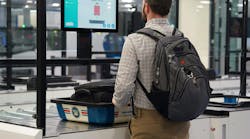As much as the industry, the public, and the media (and I) rail on the Transportation Security Administration for their perceived failings in public service at United States airports, I like to point out that TSA is but a creation of the United States Congress, and can only do what the legislation instructs them to do and provides them with the funding for doing it. Apparently the Congress has forgotten that after 9/11, it took FAA out of the airport security business and gave it to TSA. You wouldn’t know that if you had read the recently passed FAA reauthorization act -- you should and here's the link.
In addition to its presumed purpose that the name implies – reauthorizing the FAA to continue functioning before Congress skips town – they managed to cobble together some unrelated pending bills having nothing to do with FAA, but everything to do with TSA and aviation security, none of which were likely to pass before they left for their summer recess, and attached them to the must-pass FAA bill. Need I remind you this is an election year, when Congress-persons wish to declare their critical leadership role in the near-victory over the evil Empire.
They have done so by inserting a rather impressive list of mandated “security enhancement” requirements for TSA to perform in very short order, and have provided no money at all to do them. Let me emphasize that point: no funding. None. Zip. Bupkus. Nada. Zero. The single mention of funding any of these programs in the bill is found in section 3505, to run some screening checkpoint pilot programs, but with this interesting twist: “…with amounts obtained as reimbursements from airports under such pilot programs.” It’s hard to imagine many airport operators leaping at the opportunity to fund the TSA.
Among my favorite provisions is the one where the bill confuses the definitions of secured areas and SIDA. Another interesting example: the act authorizes screening equipment donations, and more, to overseas airports to bolster the security standards for flights headed to the United States from high risk airports.
Limited space in this forum doesn’t permit me to address each requirement, but you can ponder them yourself beginning with Section 3101 of Title III, titled “Aviation Security”, in the link provided above. Taken at face value, a few of them appear to actually make a bit of sense, until one continues reading and says to oneself, “Gee, that looks familiar….. so does that…. and this one… “… You get the point: virtually all of it is highly redundant with existing requirements, regulations, best practices already in place for many years, and more, --- or worse, some of them conflict with existing requirements, or in a couple of cases, are just different enough that they will have to essentially do the same thing twice, but with different data under a different cover on the report.
What this now imposes upon TSA is an entirely new series of assessments, studies, congressional reports and testimony, some of them to multiple committees, and some of them “not later than 30 days from enactment…”, which means they are already late, and Congress isn’t even in session. Further, this new crush of bureaucratic requirements comes at a time when TSA is admittedly shorthanded -- at least in the field, so I hope the headquarters dress code allows staff to wear their sneakers to work, because they are going to have to move fast.
Here’s a few:
- Requiring comprehensive security assessments for all overseas airports serving the United States
- Consider the level of information sharing and security capabilities of foreign airports.
- Authorizes capacity development, training, screening equipment donation, and cargo program certification for overseas airports to bolster the security standards for flights headed to the United States from high risk airports.
- Expands the TSA PreCheck program by directing TSA to partner with the private sector to develop enhanced enrollment and vetting methods. By developing and marketing this program, TSA can strengthen security by identifying trusted travelers, while also increasing operational efficiency of checkpoints by providing expedited screening to more passengers.
Optimizes checkpoints by redeploying certain TSA personnel and assessing TSA’s staffing allocation model, in order to reduce passenger wait times while enhancing security effectiveness.
Tightens the access controls and employee vetting standards for aviation workers with access to secure and sterile areas of airports, in order to mitigate the insider threat to aviation security.
Authorizes “Checkpoint of the Future” innovation efforts underway at TSA, authorizes additional TSA Visible Intermodal Prevention and Response teams, and ensures these teams are trained to assist transportation hubs in preparing for and responding to active shooter scenarios.



